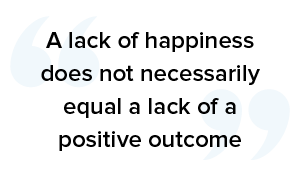Dick Bourke of Scorebuddy discusses how you can include customer emotion in your quality assurance (QA) scorecards.
Emotive Customer Experience (CX) is a vital tool for measuring and quantifying how emotions affect the customer experience positively or negatively. The idea being that a call centre agent who is trained to amplify positive experiences and transform negative experiences is much more likely to deliver an emotionally authentic and functionally effective outcome.
According to a recent report by Forrester, companies who are CX leaders outperform the S&P 500, growing their share price by 32% compared to 17%, and leaving CX laggards far behind with only 3% growth.
The question, then, is how can you use Emotive CX scorecards and metrics to improve call centre and customer service interactions, particularly when dealing with such a subjective concept as emotional response.
The Importance of Emotive CX for Brands
“Emotion management in contact centres is destined to become a major competency, change initiative, and catalyst for a whole new generation of people who are drawn to this higher-value challenge. We will need to evolve from ad hoc competency in managing emotional outcomes to embedding it as a measurable outcome for every interaction.” — Martin Hill-Wilson, Why Customer Emotion Management Matters
Martin Hill-Wilson is a global authority on social customer service and co-author of the highly successful publication, Delivering Effective Social Customer Service. As a frequent keynote speaker on the topic of Emotive CX, he is the ideal person to talk about how Emotive CX metrics can be used to improve call centre results.
According to a 2018 New Voice Media report on consumer behaviour in the UK, 63% of consumers are more likely to purchase products and services from a brand they have a positive connection to. And, potentially even more importantly, US companies lose $75 billion a year due to poor customer experiences.
There is no denying that emotions impact customers’ purchasing decisions on a variety of levels, whether positive or negative. Through active listening, live call centre agents can change the outcome of every customer service interaction by anticipating customer requests, delivering explanations, educating customers, providing emotional support, and offering a personal connection.
The key is to be able to understand and use the results of every customer interaction—through post-interaction surveys, evaluations and self-score scorecards—to improve positive and decrease negative outcomes.
To do this, agents must be trained to recognise when customers feel excited, appreciated, and happy as well as when they feel disappointed, frustrated, and angry and to move the customer along the needle towards an overall satisfactory experience.
How to Recognise Positive Emotive CX
In this blog, we’re taking an in-depth look at how to improve Emotive CX for your call centre after a positive scorecard and interaction.
The first step toward improving Emotive CX for your brand is to recognise when a satisfactory customer experience occurs. Sometimes this is as simple as recognising when a customer was moved from a negative emotion (anger) to a positive emotion (happiness). However, it’s not always this easy. Interpretation is needed.
“The ‘best’ outcome does not mean we try and nudge customers towards a predetermined set of emotions and feelings,” explains Hill-Wilson. “This is inauthentic CX even if your instinct is to target ‘happy and satisfied’ every time.”

For example, a positive outcome for an insurance call after water damage or burglary is not likely to immediately generate joy or happiness. Instead, the pathway toward a positive outcome is most likely to lead toward feelings of relief, reassurance, or feeling cared for.
A lack of happiness does not necessarily equal a lack of a positive outcome. A positive outcome should be determined based on the context of the issue being handled and the original emotional state of the customer.
The appropriate scorecard design can help you quantify how an agent–customer interaction went in regard to Emotive CX. Your goal should be to determine if the agent recognised the customer’s mood and then gave them what they wanted by the end of the service interaction.
Example of Emotive CX Indicators

The good news is that best-in-class brands average 17 emotionally positive experiences for every negative experience (Forrester), so you should have plenty of positive experiences to work with. And when that’s the case, there are four next steps you can possibly take:
- Recognise the agent who handled the positive interaction.
- Leverage the positive outcome for onboarding.
- Appoint the agent as a call centre coach for ongoing training.
- Use the interaction for call centre quality assurance.
4 Steps to Leveraging Positive Scorecard Outcomes
“How we train our teams to ‘actively listen’ and authentically respond really matters.” —Martin Hill-Wilson, Why Customer Emotion Management Matters
The goal for your call centre team is to improve customer outcomes by raising their awareness of Emotive CX within their interactions and their skill in addressing how a customer feels. The challenge is to empower your employees and put them at the centre of every metrics and performance plan.
Here are four steps your call centre team can take to improve Emotive CX after a positive scorecard.
Step 1: Recognise Great Performers
Recognise those who perform well. A study conducted by the Social Market Foundation and the University of Warwick’s Centre for Competitive Advantage in the Global Economy found that happier employees are more productive in the workplace, with productivity increasing by an average of 12%. By rewarding call centre employees who achieve positive outcomes as defined by the Emotive CX scorecard, you provide an enticing motivator for continued success.
There are various ideas for rewards and recognition including:
- Preferential scheduling, which allows top performers to bid for the best shifts.
- Job perks such as giving an agent the CEO’s parking spot for a day, a two-hour lunch, an extra PTO day, late start, or early departure.
- Recognition in the form of a high-five or callout in a team meeting, round of applause, certificate, etc.
In a Gallup survey, 28% of employees indicated the most memorable recognition they received came from their manager; 24% of employees cited recognition from the CEO. In either case, the idea is to be creative, because when asked which types of recognition were most memorable, respondents ranked monetary rewards fifth out of six.
Step 2: Leverage Positive Outcomes During Onboarding/Induction
The turnover rate in call centres is high—between 30% and 45%. However, with successful onboarding and training during year one, job retention can increase by as much as 25%.
Utilising examples of positive Emotive CX interactions with agents during the onboarding process allows you to tap into the expertise of team members for results-oriented training. This helps your agents understand your business and better empowers them to deliver their own positive customer experiences.
Step 3: Set Up Ongoing Coaching
98 percent of companies want to support the sharing of good practices and knowledge across teams via in-house social networks or functionality. Setting up your high-value agents as coaches is an effective form of ongoing training for your entire call centre.
The ideal coaching platform allows call centre leaders to share their experiences in convenient and interactive ways. Positive Emotive CX interactions should be recorded and shared in ways that provide performance insight. When coaching happens one-on-one and is simple, relevant, and collaborative, it fosters development.
Step 4: Add Emotive CX to Your Quality Assurance Programme
Call centre quality assurance programmes ensure that your customer service results match your desired outcome. By closely monitoring exemplary Emotive CX, you can set benchmarks based on performance indicators, holding your call centre up to the top performing agents. Each positive call should be looked at as a self-contained case study that helps you determine what your call centre or customer service experience is doing well and where improvements can be made.
The Lifetime Value of Positive Emotive CX
“Emotive customer experience recognises that our decisions are driven by deep-seated motivations: the things that really matter to us in terms of identity and personal fulfilment. Tap into these, and customers become more valuable in every respect: from advocacy to lifetime spend.” —Martin Hill-Wilson
Emotive CX scorecards have a lifetime value for your customers. Theoretically, you could take the data from your positive scores and customer interactions, measure the outcomes, record the results in your CRM, and, over time, determine the correlation of those positive outcomes.
The ultimate goal of your Emotive CX metrics should be to gain insight into the overall customer impact by linking customer emotional management with enterprise success to see how specific positive emotions can trigger customer loyalty, greater spending, and increased lifetime value.
- Customer Loyalty: 86 percent of customers claim that a positive emotional connection with a customer service agent would make them more likely to do business with that brand again (NewVoiceMedia).
- Customer Spending: There’s a direct link between positive Emotive CX and annual revenue. According to Harvard Business Review, for transaction companies, clients who had the best experiences were shown to spend 140% more than those with the worst experiences.
- Customer Longevity: Customers who score their positive experiences with the highest ratings have a 74% chance of still being a member in a year. “Customers who have great experiences will remember them long after they have forgotten the price they paid.” —Martin Hill-Wilson, Managing Emotive CX for Customer Interaction.
Positive Emotive CX Lasts Long After the Service

Dick Bourke
There’s a lot that goes into recognising, measuring, and acting on positive Emotive CX, but the end results are worth it. By improving your customers’ interactions with your company through appropriate training, QA, and recognition programmes you can directly impact your brand’s bottom line.
“We must satisfy both functional and emotional needs if we want to win the long-term commitment of our customers. In other words, delivering positive experiences is critical to revenue growth.” —Martin Hill-Wilson, Why Customer Emotion Management Matters.
It’s in your best interest to measure every customer experience and use the results to continually improve.
This blog post has been re-published by kind permission of Scorebuddy – View the Original Article
For more information about Scorebuddy - visit the Scorebuddy Website
Call Centre Helper is not responsible for the content of these guest blog posts. The opinions expressed in this article are those of the author, and do not necessarily reflect those of Call Centre Helper.
Author: Scorebuddy
Published On: 25th Jan 2019 - Last modified: 19th Aug 2024
Read more about - Guest Blogs, Martin Hill-Wilson, Scorebuddy






 Scorebuddy is quality assurance solution for scoring customer service calls, emails and web chat. It is a dedicated, stand-alone staff scoring system based in the cloud, requiring no integration.
Scorebuddy is quality assurance solution for scoring customer service calls, emails and web chat. It is a dedicated, stand-alone staff scoring system based in the cloud, requiring no integration. 









